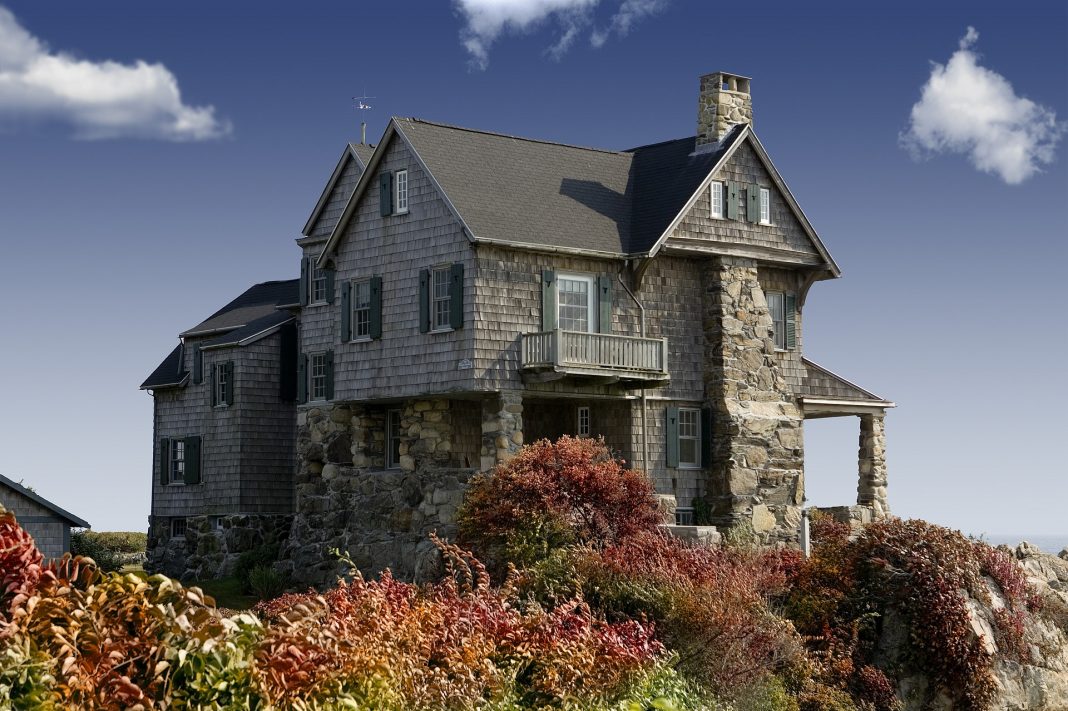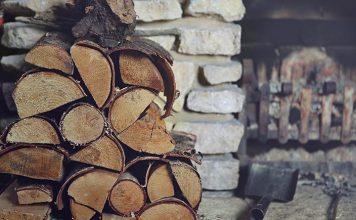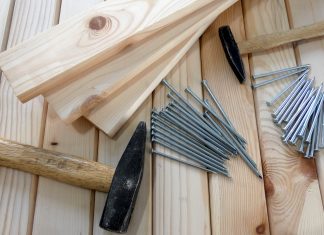| Issue #92 • March/April, 2005 |
It is pretty devious starting off an article with an exaggeration but now that I have your attention let me tell you about a floor surfacing method I have been using over the years that performs better than what you are used to. It is waterproof for outside applications. It is easily repaired when damaged. It is slip resistant and easy to clean. It can be fitted into difficult or complicated locations. It comes in any color or style you can imagine and can be redecorated easily at any time. Best of all, it allows you to express your artistic talent. Plus this surfacing method isn’t limited to being used only on a floor. With proper care it could quite possibly last forever.
A good, long lasting floor needs a solid, fairly smooth subfloor. Concrete certainly qualifies but the most likely surfaces are plywood or an old floor that needs refinishing. When I show you how this system is applied you can decide what will be involved in preparing the surface for your individual project. I have had some interesting results covering less than uniform floors by using this method.
Once the floor is stable, dry, clean, and all holes larger than .30 caliber have been filled with wood putty you can begin. This system uses Plastic Roof Cement (PRC) to bond 90# roll roofing to the floor. I know, you’re shocked. Before you turn the page muttering something about ‘tar paper shacks’ just bear with me a few more minutes.
|
The roofing material for this job must have complete mineral coverage. Some manufacturers leave a two-inch lap strip. You don’t want that. Be sure to check each roll in order to get the right stuff. Exchanging heavy rolls of roofing annoys everyone involved. The color you buy does not matter.
Putting the floor down
Measure and accurately cut a length of 90# roofing that just fits the room from wall to wall. Using a measuring tape, tee square, and a sharp utility knife, cut the roofing material on the backside, not the mineral side. Lay it down on the floor on one side of the room. Be sure it lays flat. If you have mopboards, and even if you don’t, be very accurate with your cuts and placement. Now roll up four or five feet of the piece of roofing so that the mineral side is inside the rolled up part.
Use a small hand brush or a large paint brush to remove the last bits of dirt and dust. Then, with a large putty knife, trowel, or similar tool, extract some PRC (Plastic Roofing Cement) from a five-gallon bucket and place blobs of it on the part of the floor you just uncovered. Spread the PRC with a serrated trowel. I use a 3/8-inch serrated trowel for most projects. Work slowly and apply an even thickness (3/8 inch) to completely cover the work area. Small indentations, nail holes, floor seams, and other minor imperfections should be filled with PRC.
Roll the roofing back down onto the floor. Go to the other end of the piece of roofing and roll it up to where the PRC is just beginning to be exposed. Put yourself and your bucket of PRC on the covered section of floor behind the roll. Blob and spread PRC ahead of the roll and work your way across the room unrolling the material as you go. Take your time doing this part of the job. Too much PRC makes a lumpy floor that won’t last. Too little is better than too much. A firm continuous bond is imperative. Don’t use any nails or staples.
After the first piece of material is glued down it can be “slipped” around slightly if it is not perfectly straight and flat. One foot on the material and one on the bare floor or both feet on the material and pushing against the wall with your hands is enough leverage to adjust the position of the piece. Do this slowly and carefully because I think you can imagine the laughs you will get if the slipping part goes wrong.
|
Cut the second piece of material and repeat the procedure. This time, however, you have the added task of making sure the seam is exactly aligned. Careful trowel work is necessary to get the seam securely bonded without too much oozing of PRC, or too little PRC in order to stick it down. Remember, go slow and be meticulous. This is a Forever Floor and worth the trouble.
The temperature during this installation has an effect on how well the job proceeds. Warm is better. PRC spreads best when it is from a freshly opened bucket and the temperature is above 70° F. Higher temperatures extend ‘slippage’ time. I have not kept track of how much coverage a bucket of PRC gets. It varies with the volume of voids it has to avert. (Sorry.)
Be aware that PRC takes a few days to cure. Some circumstances may require putting weights on parts of the floor where bonding is reluctant. Concrete blocks, extra cans of paint, lumber, brothers-in-law, sacks of cement, or whatever you have for ballast will work. Just be prepared to leave the items in place for a couple of days. Most times this won’t be a problem if the temperature is right and the PRC thickness is uniform. During installation, wear good, thick knee pads to preserve your knee joints for old age.
Cleaning up
If, like me, you have the occasional dufus moment and get PRC where it should not be, clean it up right away because it has the ability to travel. Blot up PRC with a rag if it gets on the mineral side of the roofing. Leaving a little discoloration on the minerals is okay. It will be fixed later. Clean tools and their handles with paint thinner or spray degreaser and a rag. Don’t let it linger on your hands. I think it may be what melted my fingernails one time.
WD-40 and a rag are best for skin, shoe sole, and kneepad cleaning so keep these items handy. Don’t hesitate when some PRC escapes. Deal with it immediately. It will save you a lot of trouble in the long run.
|
To keep the person responsible for laundry happy, wear clothes from, or about to go to, the rag pile. Then burn them after the job, if necessary.
Let’s recap. Prepare the floor by nailing down loose parts. Fill large holes. Get it fairly smooth and clean it well. Accurately cut the roofing pieces and bond them to the floor with Plastic Roof Cement.
Painting
Before we start the next step I am going to tell you a secret you must protect with the same self-discipline you guard your source of…ginseng plants. Customers of the local paint supply store often return or reject paint that for some reason turned out to be the wrong color. Many stores throw it away. Can you believe that? But they’ll sell it cheap if you know it exists, they like you, and you ask for it. I’ve gotten some of the finest quality paints for…well, very cheap. Get all you can. I have acquired as much as 35 gallons at a time. For our purpose here, use only latex paint. Any color, gallons, quarts, gloss, flat, exterior, interiorit doesn’t matter. They all work. You can understand that if everyone knew about this secret there wouldn’t be any when you need it so stifle the urge to share this knowledge.
You probably have guessed that the roll roofing floor is going to get painted. Before we talk about that, let’s examine an advantage of this method. Often, when a building is going up, a new floor is exposed to the weather for many days, maybe weeks. Covering it with bonded roll roofing prevents damage caused by dew, rain, and hot sun. I apply roofing material right out to the perimeter of the floor as soon as it is built, then erect the walls on top of it. This creates a gasket-like seal between the floor and wall plates. And doing it at this time, in this way, is easier than working up to the wall later. Damage is minimized during construction and throughout the life of the building when water is prevented from soaking through the floor.
Now let’s appreciate the reasons for all that latex paint. If you simply cemented down the roofing material and started walking on it, the minerals would become dislodged and the floor would wear out quickly. You may have seen roll roofing nailed to docks and piers at marinas. It doesn’t last long and needs replacing often, but it makes a pretty good non-slip walking surface.
Latex is not just paint. It is good glue, too. Two or three coats of it encapsulate the minerals on the roofing material and hold them in place like they were welded there. More importantly, latex paint absorbs the wear the floor receives. When the minerals start to show, you paint the floor again. And that is the key to the superiority of the forever floor.
Let’s get back to that fresh new floor covered with roll roofing. Sweep away the few loose mineral granules and get the first two coats of paint applied as soon as possible. It’s easy. If you are working up to a wall, use a brush to cut in around the perimeter of the room. Then just pour the paint from the can onto the floor and spread it with a long handled paint roller. If there are no walls yet, just pour and spread. Play nice music while you paint and it is a wonderful, almost Zen-like, experience.
|
Be smart. Use the most repulsive color paint for the first few coats and save your favorite for last. When I am doing a floor that will be exposed to weather I apply two coats right away before it rains. Latex dries in an hour or two so the job can be done in one day. Two coats give me a good work surface while I build. Later, when all else is done, I can touch up and do the finish painting. If your floor project is outdoors, put two additional coats down for a finished surface that lasts years before needing a recoat. Indoor floors do fine with only three coats since the weather is usually not so harsh inside your house.
You may have access to oil paint but I do not recommend it for your floors because dust and cat paw prints get on it before it has a chance to dry. Even under the most favorable conditions oil paint can take days to cure enough to allow foot traffic. If you cannot live without that certain color that only comes in oil…well, don’t say I didn’t warn you.
If you still think this is just glorified tarpaper, get a magnifying glass, lie down on the floor and scrutinize it. The latex has covered and filled in between all the granules and holds them forcefully in place. The granules combined with the latex makes a surface almost as hard as rock. The bumpy texture creates a non-slip surface, yet it is smooth enough for easy sweeping and mopping.
Repairing your floor
Forever is a long time and some calamity may occur which pokes a hole or gash in your floor, necessitating a repair. Compared to vinyl or wood, this floor is a cinch to fix. Cut a new piece of roll roofing in a football shape just large enough to cover the mishap. Use a magic marker and trace around the football shape. Use a sharp utility knife, perhaps a chisel, and cut on the lines you traced. Scrape away the old roofing material inside the lines and down to the sub floor. This isn’t easy so persist carefully. Make sure the new piece fits into the cutout closely. Cement the new piece in place with you-know-what and paint over it with latex. Sit on a chair over the repair to guard it while the paint dries. Enjoy the beverage of your choice and feel proud of yourself.
Sometimes you might have a particularly difficult location that needs floor covering. Perhaps your architect, in a fit of artistic flair, designed a really complicated hallway, niche, staircase, or something. Ordinarily it would be carpeted because carpet is easy to carve into odd shapes and tack into place. Maybe vinyl was chosen, or hardwood flooring. These are good but expensive solutions, not so much in materials, but skilled labor. Plus they all have to be refinished or replaced after a few years because of wear or boredom.
This floor excels in these places. When applied during construction the job is done inexpensively. If done by you in an existing building it still keeps the floor covering budget in check.
Sections of roofing material can be cut and installed like puzzle pieces once you become adept at doing the geometry and aligning seams. This advantage makes the roofing material method easier than trying to install one really complex hunk of carpet or vinyl and with less waste.
Remember, once in place, this floor does not wear out. As for preventing floor covering replacement on account of boredom…well, just read on.
Artistic expression
Now comes my favorite subject: artistic expression. After your two or three coats of inexpensively acquired latex paint have been applied and your floor is up to its potential in the matter of wear, you are going to look at it and wonder how you will ever get comfortable with that Turkey Trot Teal, or whatever that last color was called.
|
Fortunately, you can fix all that. Push the budget limits and go buy some colors you really like, at retail prices, to decorate the floor. This endears you to the paint dealer and he will be inclined to let you have more of his mis-mixed paints later.
Study the pictures accompanying this article and you’ll notice I get carried away a little bit with colors. I do have a method however.
Step 1: Use a background color, or two or three. If you use only one background color just do the whole floor with it and proceed to the next step. If you use two or more backgrounds, divide the floor into sections, relevant only to you, and use separate colors for each. Use background colors that contrast or complement, but do not clash with, the finish colors.
Step 2: Put on the finish colors. You’ll notice I paint the floors in a mosaic pattern. This is easy and my favorite method but you can conjure up your own style. Limited only by your imagination, the possibilities are infinite. The fact that latex comes in gloss, semi-gloss, and flat provides you with another design element to play with.
I do my finish painting in stages and this is how it works. Each night about an hour before bedtime I take my color of the day and a two-inch brush and paint a number of individual, various sized, spots on the floor. They are dry by morning and do not disturb our daily activities. Next night I use another color and add more spots, keeping a margin between them, allowing the background color to show. Eventually the whole floor gets done.
I don’t clean the paintbrush between sessions. I just store it in a plastic bag to prevent the paint from drying and use it again during the next session. Intermingled coloring is a technique I use, so for me a clean brush is not necessary. This work is so pleasant that it is tempting to just go right out the door and paint the pavement in the driveway. In fact, I have done that.
You can make the floor look like patio stones. You can paint “carpets” or scenes on the floor. This technique is called trompe l’oeil (pardon my French). Trompe l’oeil means “fool the eye.” In case you would like to study up on it, books have been written about painting floors as art. You can help bring this art form back with your own forever floor if you are so inclined. What’s really cool is, even if you screw up or change your mind, it’s okay. Just paint over it.
|
Repainting is what keeps your forever floor dear to you. Tired of it? Repaint. An accomplished artist comes for a visit? Make him or her work for their keep. Each layer of paint makes the floor last longer. Artwork makes it more valuable and attractive.
You could paint any old floor made of concrete or wood. I have done both but there are problems. Concrete tends to slough off paint with changes in humidity and temperature. There is a way to pour concrete so it accepts paint effectively but that is another story. Concrete has sort of an evil mystical power to make a person’s legs tired if they have to stand on it too long. A layer of something between you and the concrete breaks that spell. Don’t ask me why. It just does. And the local Masonic Lodge guys aren’t letting loose the secret reason for this phenomenon. I asked.
Painted wood just looks like…well, painted wood, which is okay if you like it. By adding bonded roll roofing and paint you give the floor a new dimension and longevity. Old wood plank floors should be saved and restored with reverence. But if you have a fairly recent hard or soft wood floor with little gaps, dents, dings and such, covering it with this system turns it into a very interesting new floor. If, later on, carpet or wood must be added, either can be installed over this material.
Other applications
Now that you know about the forever floor, imagine the constant counter. I have built several of these in kitchens and bathrooms. It is easy to make a large, long countertop with no seams.
Imagine a few more applications. How about the eternal tabletop, continual seat and ceaseless shelf? All are good projects for using this method. I have used it to create non-slip walkways or, as I call them, permanent pathways, on the boat I am building. When I build a counter, shelf, tabletop, or stairs I add a perimeter of hardwood molding to protect the edges of the roofing material. Other than that it is the same process as the floor. There are better adhesives than PRC for these nonfloor projects if you want to try them. Various construction glues work okay.
People who have seen the forever floor often don’t believe their eyes, or me, when I tell them what it is. Other than certain grades of vinyl, there are no closely comparable floor coverings, which make real estate appraisers apprehensive. But once you see how inexpensive, durable, and beautiful this floor is, I think you’ll agree that the forever floor is worth it.





















